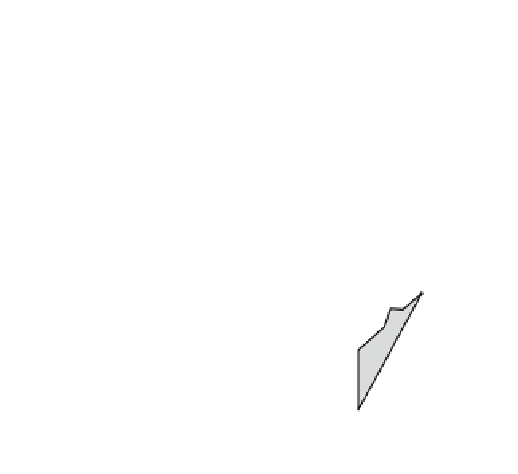Geoscience Reference
In-Depth Information
Strike-slip
Dip-slip
10.0
Tsunami earthquakes
?
Tsunamigenic earthquakes
?
8.0
Unimak Island 1946
Sanriku 1896
Kurile Island 1975
6.0
Kurile Island 1963
Thrust-dip
Back arc thrust
Java 1994
4.0
Island arc
Nicaragua 1992
Rupture
length
Peru 1994
Inter-plate
thrust
2.0
Subduction
zone
7.0
8.0
9.0
Back arc thrust
Moment magnitude,
M
w
Fig. 5.2
Types of faults giving rise to tsunami. Based on Okal (
1988
)
and Geist (
1997
)
Fig. 5.3
Relationship
between
moment
magnitude,
M
w
,
and
the
average slip distance of an earthquake. Based on Geist (
1997
)
below the seabed to the surface, the thrust fault, which is
characteristic of subduction zones (Fig.
5.2
), becomes the
preferred fault mechanism for tsunami generation. The
greater the vertical displacement (or slip), then the greater
the amplitude of the tsunami. The dip-slip mechanism is
ideal for generating large tsunami. Where uplift occurs, a
wave propagates with a leading edge; where subsidence
occurs, the wave propagates with a receding backwash
(Murata et al.
2010
). Nowhere has this been more strikingly
illustrated than with the generation of the Indian Ocean
Tsunami of 2004. The east coast of India and Sri Lanka
faced the zone of seafloor uplift and witnessed a wave crest
approaching the shore. On the west coast of Thailand, which
faced the zone of seafloor subsidence, water dramatically
withdrew from the shoreline before the tsunami wave rolled
in Ammon et al. (
2005
), Subarya et al. (
2006
).
About 90 % of earthquakes occur in subduction zones
and these areas are the prime source for tsunami (Satake
1996
). Subduction zones typically have average dips of
25 ± 9, while the largest tsunami run-up is associated
with higher dip values of between 20 and 30 (Geist
1997
).
As the dip angle decreases, the tsunami is more likely to
have a leading trough. Faulting along subduction zones also
results in subsidence at the coastline, a feature that com-
pounds tsunami inundation for local earthquakes. Two
tsunami actually develop in this case, one propagating
shoreward and the other seaward. This tends to produce
waveforms of different characteristics. The portion propa-
gating seaward has a flatter crest and smaller amplitude than
the wave moving landward. Large tsunami are not restricted
to subduction zones. For example, back-arc thrusting away
from a plate boundary (Fig.
5.2
) produced the Flores,
Indonesian Tsunami of December 12, 1992 and the Hok-
kaido Nansei-Oki Tsunami of July 12, 1993 (Satake
1996
).
In addition, the November 14, 1994 Mindoro, Philippines,
Tsunami, which killed 78 people, was generated along a
strike-slip fault, while the October 4, 1994 Kuril Islands
Tsunami originated from the middle of a subducting slab.
These anomalous events may also have involved a sec-
ondary mechanism such as a submarine landslide.
The greatest slip along faults tends to be concentrated
towards the center of a rupture, and this can result in a
higher initial tsunami (Okal
1988
; Geist
1997
). This
abnormal amplitude may not be detected if the degree of
slip along a fault is averaged. Tsunami earthquakes tend to
have much greater slip displacement than tsunamigenic
earthquakes of comparable magnitude (Fig.
5.3
). For
example, slip displacement for a tsunamigenic earthquake
with a moment magnitude, M
w
, of 8.0 is only 2 m. The
equivalent tsunami earthquake has a value that is more than
double this. The length and orientation of a rupture are also
important in the generation of a tsunami (Geist
2012
).
Length obviously correlates with the amount of seafloor
displacement. Analyses show that the amplitude of a tsu-
nami is proportional to the cube of the length of rupturing.
Long ruptures such as those that occur along the coast of
South America have the potential to produce the largest
Pacific-wide tsunami. Rupturing over a 1,000 km length of
fault line caused the exceptional 1960 Chilean Tsunami.
At the other extreme, if the tsunami wavelength that is
generated by an earthquake is less than the rupture length,
then there is a beaming effect (Okal
1988
; Geist
1997
). For
this reason, tsunami earthquakes, also have higher directivity
and so can produce higher wave run-up along narrow sections
of a coast. The effect of beaming or directivity on a coastline
depends upon its orientation relative to that of the rupturing
fault line. Most subduction zones in the Pacific Ocean direct
















































































































